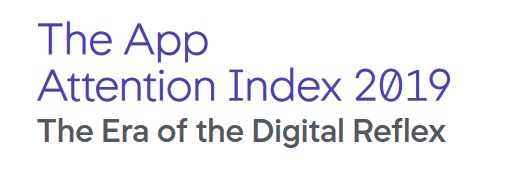
Today's always-on, constantly connected consumers run on applications — from the moment they wake up in the morning (asking Alexa for the day's weather report) until they go to sleep at night (tapping their Smartwatch to track their nocturnal cycle). People expect the host of applications they use on a daily basis to deliver exceptional digital experiences, but matching performance with consumers' expansive and increasingly complex demands is near impossible without a robust application performance monitoring (APM) solution.
The new App Attention Index Report from AppDynamics finds that consumers are using an average 32 digital services every day — more than four times as many as they realize. What's more, their use of digital services has evolved from a conscious decision to carry around a device and use it for a specific task, to an unconscious and automated behavior — a digital reflex.
Additionally, the number of consumers claiming to be more loyal to an app than a brand has doubled over the last two years (46% in 2019 compared with 23% in 2017). Imagine, then, their genuine disappointment and anger — e.g. cursing, throwing phones and/or becoming irritable with those around them — when performance lags. In fact, the vast majority (84%) of consumers have experienced problems with digital services in the past year, leading half (49%) to switch to competing brands or suppliers.
So what does all this mean for the IT teams driving application performance on the backend? Bottom line: delivering seamless and world-class digital experiences is critical if businesses want to stay relevant and ensure long-term customer loyalty.
Here are some key considerations for IT leaders and developers to consider:
Make Better Decisions Faster with Real-Time Monitoring
It is essential for IT teams to deliver top-notch digital experiences across the full technology stack, from application development all the way to end users' devices. Enterprises should consider taking an AIOps approach to their real-time data monitoring — which leverages the power of artificial intelligence, automation and APM to help IT teams tackle performance issues before they become customer-impacting problems.
By switching to an AIOps model, APM vendors can quickly identify business-impacting problems from vast amounts of data — yielding insights that businesses can easily understand and can help them prevent problems from happening in the future. For digital enterprises, automating root cause analysis through machine learning is one of the best and fastest ways to increase agility in the face of potential downtime.
Converge Business Outcomes and Application Performance
In today's digital-first world, aligning application performance to business outcomes is no longer a question — it's a requirement for survival. By correlating data across monitoring silos into a single source of truth, APM is able to track and aggregate information across the enterprise, on almost anything that could impact app performance (CPU usage, error rates, response times, customer satisfaction and more).
This correlation saves IT teams time that would be spent manually searching through individual event logs or building synthetic monitors. More than that, and the most critical piece of information for digital enterprises — using technology that connects application performance, user experience and business outcomes allows organizations to improve decision-making and take action based on real-time data and insights.
The good news for organizations is that APM technology is evolving at the same pace as consumer expectations. Digital enterprises need to be aware, however, that the technology is most effective when adopted across the entire organization. Doing so not only maps application performance back to business objectives like customer experience and revenue, but helps to ensure digital services — from production, to monitoring to deployment stages — are the top priority for decision makers across your company.
These are just a few considerations for business and IT leaders to consider when it comes to rethinking their APM approach amid shifts in loyalty from brands to apps. Ignoring the impact that AI and machine learning could have on your digital service performance, customer experiences and, inherently, your bottom line - could plague or irrevocably damage your business for years to come.



